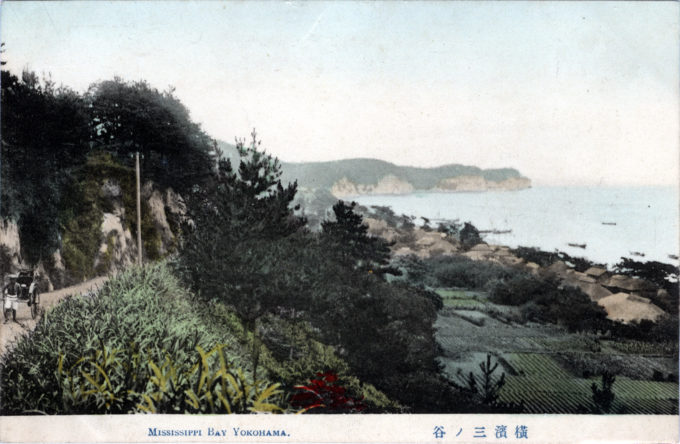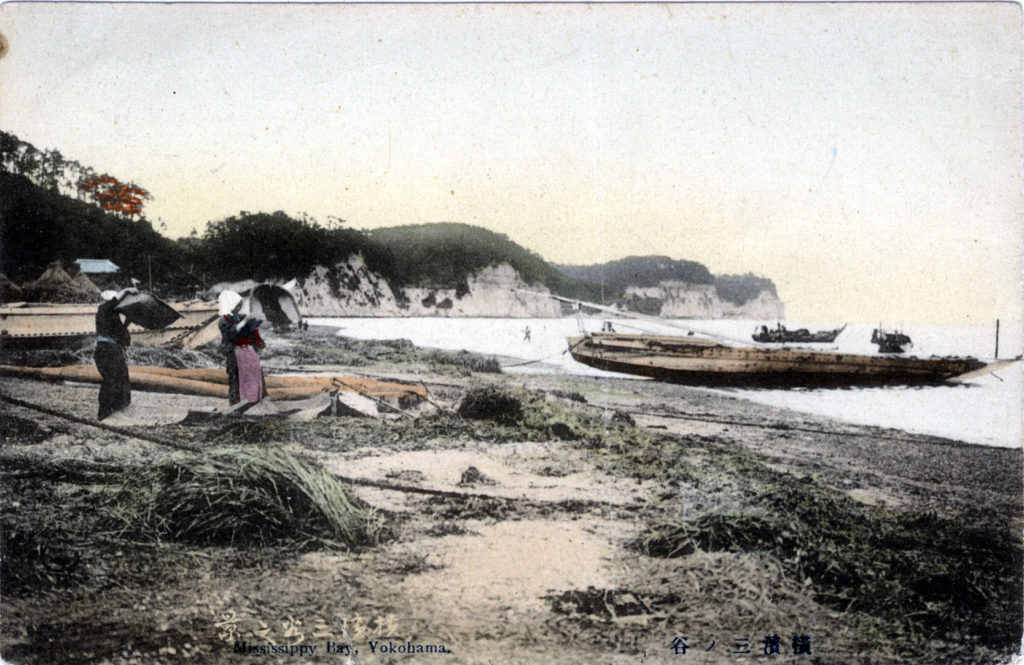“Mississippi Bay (Negishi), formed between Treaty Point to the northward and Graham Bluff to the southward, is well-sheltered from the prevailing winds. Treaty Point and the shore westward is shallow to the distance of about a mile, and there is a 3-fathom patch near the center of the bay 1/2-mile southeastward of the pier-head. Shallow water extends 3/4-mile northeastward from Graham Bluff, and an isolated shoal of 3-fathoms lies 1 mile 47° from the bluff. There is anchorage in the bay in from 6 to 9 fathoms. avoiding the above mentioned dangers.”
– Asiatic Pilot: The Japan islands, by the United States Hydrographic Office, 1910
“The Approach to the far-famed Yedo Bay and to Yokohama city is unusually attractive. As ships from Canada and the United States steam in from the broad Pacific and prepare to round the outermost point of the Awa Peninsula (right), the island of Oshima with its active Mihara volcano is visible (left) on a clear day. At night, a deep fiery glow is often reflected in the sky. Ships bearing in from the SW pass between Oshima (right) and the Izu Peninsula. Sagami Bay is now at the left and at Misaki ,near the S tip of the Sagami Peninsula, is the Marine Biological Laboratory.
“Sugita, a somnolent fishing village about 5 M from the Grand Hotel, faces Mississippi Bay and is of interest chiefly for the plum trees which bloom in profusion in early spring. A quick and cheap way to reach it is to board a tram car at Kaneno-bashi [in Yokohama] and proceed to Yawata-bashi at the mouth of the canal. From the end of the main street of Isogo village, it is a pleasant stroll of about 1 hr tram cars are available along a road flanked by iris gardens, brilliant in June and the sea.
“Sugita can be reached on the trip to Mississippi Bay and Negishi by turning left at lower Negishi and following the sea to Yawata Bridge or on the return in a motor car from Kamakura. High sounding names are given to certain of the older plum trees at Sugita – ‘Old age nourishing plum’, ‘Crystal curtain plum’, etc. The custom of writing verses on a fancy paper called tanzaku and attaching the strips to the trees is still in vogue the less innocent one of imbibing more sake than one can conveniently carry is not in a decline. The aesthetic taste can be pampered here by eating rice cooked with plum blossoms or the less dainty one with plum pickles, the specialty of the village.”
– Terry’s Japanese Empire, T. Philip Terry, 1914
[Footnote: The names ‘Treaty Point’ & ‘Mississippi Bay’ are relics of the first arrival of the Black Ship squadron in 1853. (Commodore Perry’s flagship was the USS Mississippi.) The opening of Yokohama Port to trade, in 1859, is annually celebrated by Japanese and foreigners alike; the streets are decorated with flags and bunting; the various nationalities fraternize; unruffled amity and good mark the joyous occasion.]



